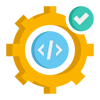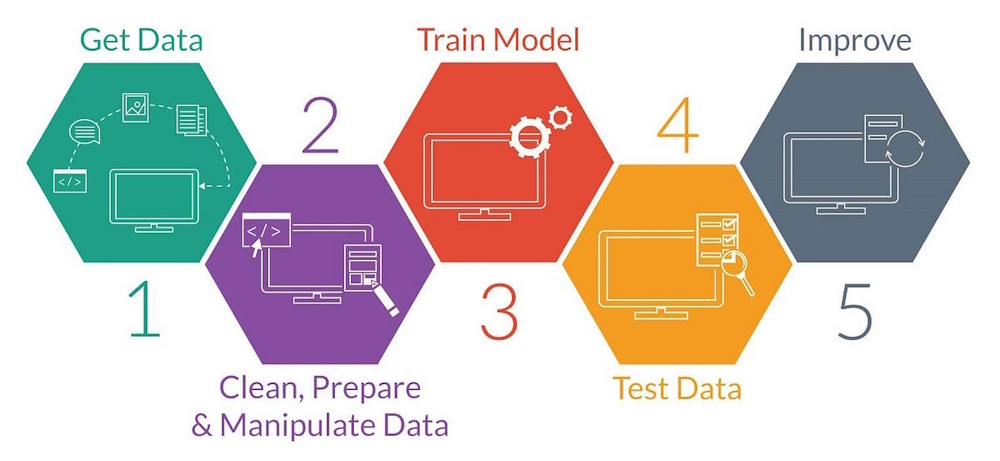 Creating
AI Models
Creating
AI Models
Building an AI app or model is a process that requires an understanding of computer software and the principles of AI and how they're applied
Related: AI on Github AI Code Generators
An intelligent AI application or model is characterized by its ability to learn, reason, understand, adapt, interact, solve problems, and generate accurate results. For example, a popular model like ChatGPT is one example of an intelligent AI model. It can generate human language text in response to commands, and do things like identify objects and people and places in photos. It can generate text in a variety of languages and format responses tailored to a fifth-grader or a rocket scientist.

An AI model describes an AI system with a high level of cognitive capacities and the ability to carry out challenging tasks with comprehension and judgment comparable to human intelligence. These models are created with complex algorithms and deep learning strategies, frequently incorporating neural networks. This enables them to process huge volumes of data, recognize patterns, and anticipate or take actions based on the inputs.
To build an AI model requires choosing relevant algorithms and neural networks, tuning hyperparameters, and training using labeled data. For practitioners, constructing and training AI models is commonly performed using machine learning frameworks like TensorFlow and PyTorch. For beginning and intermediate developers, popular user-friendly platforms like Keras or Microsoft Azure AI can simplify the process of building a model.
 Steps in
Creating AI Models
Steps in
Creating AI Models
If you're new to software development, the following list can seem daunting, but powerful software tools and the principles you're learning here make the task easier to accomplish.
Here's how to build a model, step by step:
1. Define the problem and identify goals: Identify the specific issue or task for your AI model. This could be anything from predicting stock prices, to recognizing objects in images, responsing to customers, to virtually anything you can imagine. It helps to identify the desired outcomes and some possible challenges along the way.
2. Collect and process data: Choose relevant datasets that reflect real-world scenarios. This could be text, images, audio or numerical data. Then clean your data to remove any noise or inconsistencies. This might involve normalizing values, dealing with missing data or converting data into a format suitable for model training. For best results, always label and manage data effectively. The more diverse and extensive the data, the better the model will perform.
3. Choose an AI framework or software tool: Popular options include TensorFlow, PyTorch, Keras, AI Builder, and Scikit-learn. Select the framework or tool based on your needs and level of expertise. Python is a popular language for AI model software development.
4. Design the model architecture: Choose appropriate algorithms and techniques like neural networks or machine learning models. For image recognition, an appropriate algorithm might be convolutional neural networks (CNNs), while for natural language processing, transformers could be best.
5. Train the model: Split data into training, validation, and testing data sets. Feed your data into the model and let it learn the patterns. This involves multiple iterations called epochs where the model's parameters are adjusted to minimize errors and optimize performance.
6. Evaluate, tune, and test: Test the model on a separate dataset to see how well it performs and ensure it can process new data. Assess model behavior using relevant metrics. Iterate and refine the model by adjusting the hyperparameters, such as learning rate and batch size, to improve the model's performance. This is often done through trial and error.
7. Deploy the model: Once satisfied with the model, deploy it into a production environment where it can be used to make predictions or perform tasks, according to its intended use. How to deploy the model will depend on the chosen framework or tool. Continuously monitor the model's performance and update it as needed. This might involve retraining with new data or adjusting the model's parameters.
8. Monitor and maintain: Continuously evaluate the model's performance. Update and retrain as necessary to maintain accuracy. Software maintenance is a continuous process of design, build, test, and deploy.
 Helpful
Tips
Helpful
Tips
- Begin with simpler algorithms that are easy to understand and implement, and with user-friendly tools like drag and drop software
- Learn a programming language such as Python, the preferred language for AI model building
- Use open-source tools and libraries like TensorFlow, scikit-learn, and PyTorch
- Seek help from AI chatbots, software developers, and user groups
- Examine published models from websites like Hugging Face
 Links
Links
Our latest models from Google AI
appinventiv.com/blog/how-to-build-ai-model/
softwaremind.com/blog/how-to-create-an-ai-model/
autogpt.net/how-to-create-your-own-ai-model-or-app-from-scratch/
learn.microsoft.com/en-us/ai-builder/build-model
textmine.com/post/how-to-build-your-own-ai-model
cloud.google.com/vertex-ai/docs/training-overview
reddit.com/r/ArtificialInteligence/comments/133h6d1/how_does_one_make_their_own_ai/
pecan.ai/blog/3-ways-build-your-own-ai-model/
linkedin.com/pulse/building-your-first-ai-model-beginners-step-by-step-lozovsky-mba-tmeac
builtin.com/articles/ai-models